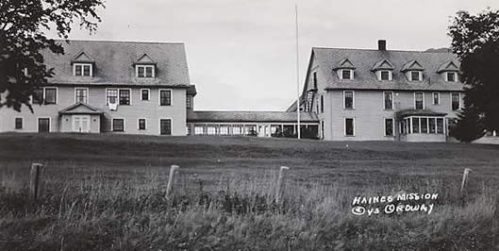Haines House served as a “home” for many Alaskan children from l921 until l960. It was designed to serve orphans, half-orphans, wards of the court, and children from remote villages where schools were not available. Sponsored and supported by the Presbyterian Church in the U.S.A., it was administered by the Educational and Medical Unit of the Board of National Missions, whose offices were in New York City. The history of Haines House began in l879 when a mission site was selected for Tlingit people living in the Chilkat and Chilkoot valleys.
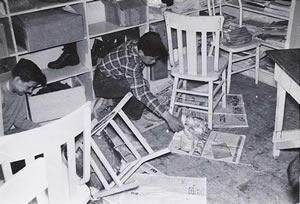
Haines House boys painting chairs they most likely built in the woodshop. Photo from Isabel Miller’s Scrapbook.
Haines House children attended the Bureau of Indian Affairs Government School until it closed in l947. They then attended the Haines Public School. Older children either went to Sheldon Jackson School in Sitka or attended Haines High School.
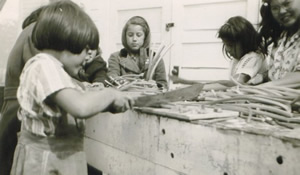
Haines House children cuttiing rhubarb from Haines House rhubarb patch. Some “town children” stopped to observe and take a sample.
Haines House children learned more than just academics. They loved music and liked to produce it themselves. They grew less shy about singing and playing in public after the move to public school. Most of the youngsters had an eye for color and/or design as well. When encouraged, they did well in artwork and crafts. The addition of a wood-shop to the recreation building in l945 was good for the boys who were clever at sawing or whittling boats, guns, swords, and other toys for their play. The older boys made items they could sell for spending money, while the girls produced saleable trinkets of felt and beads. Every child had a chore before or after school, but there was plenty of time to play games, go coasting, listen to the Victrola, make something in the shop, or try new hairdos.
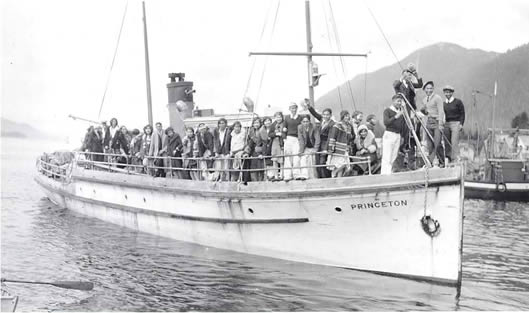
Haines House students arriving in Sitka aboard the Haines Mission boat Princeton, mid 1930s.
Most of the villagers fished, so children of Southeast Alaska were well acquainted with boats. Those who made trips to larger communities, Juneau for instance, returned with stories of elevators, busses, and cars with horns that went “beep-beep” instead of “oogah-oogah”. For many years all the children of Skagway and Haines, including Haines House, rode to Lake Bennett on the White Pass and Yukon Railroad for a special picnic including baseball and swimming as well as lots of food.
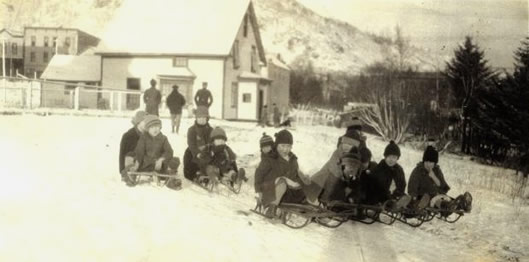
“How we love the snow! Taken in the early spring. A group of our {Haines House} little girls at the head of a hill starting for a coast.” Martha Pippereit Photo Album, 1925.
Sadly, Native tongues were little used so only children who returned to their Native villages during summer vacations remained fluent. Miss Jackson, the first supervisor, helped older children retain their language abilities by asking them to explain unfamiliar things and activities to newly arrived younger children.
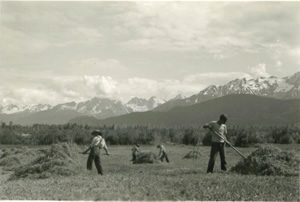
Haines House boys harvest hay from a field near 18 mile Haines Highway.
Over the years needs changed from younger children to adolescents. The cottage plan was experimented with as newer studies showed this superior to institutional care. It became difficult to hire supervisors with sufficient training to cope with new problems. The buildings needed major repairs. In July l960, faced with the ultimatum of renovating or closing, the Board of National Missions closed Haines House. The buildings were razed. Materials were used for other building projects in town, and the new Presbyterian Church was constructed on the foundation of Wheeler Hall, the Boys’ House.
Elisabeth Sheldon Hakkinen, 1992
Haines Mission Timeline 1879-1960
- 1879
- Mission site of over 266 acres chosen by S. Hall Young, John Muir and Chilkat Chiefs.
- 1880
- Mrs. Sarah Dickinson hired as first teacher. School was in a NW Trading Co. Building.
- 1881
- Rev. Eugene and Caroline Willard arrived with daughter. He preached, she taught day school. They constructed the first mission building. Mission bell arrived.
- 1884
- Log school with dormitory constructed. Government took over school the following year.
- 1896
- Log school destroyed by fire.
- 1897
- New 3 story building completed. Again took boarding students for a year then became a day school.
- 1903
- Willard Home opened as boarding school with students providing own food.
100 acres given to the Army for Ft. William H. Seward. - 1907
- New Government school constructed. Mission became a hospital
- 1916
- Mission became an isolation hospital for measles and tuberculosis and a training school for nurses
- 1918
- Building rented as a TB sanitarium. Replaced shortly by a new government hospital in Juneau
- 1921
- Mission building was reopened as Haines House, a home for orphan and half-orphan children attending government school. “Mother” Emma Jackson was Director. At age 12 or Grade 7, students transferred to Sheldon Jackson School in Sitka.
- 1924
- 1.068 acres on the SW corner of Third and Main was donated for new Haines school.
- 1927
- Wheeler Hall built just south of Haines House. Connected by a passageway, it became the boys house and included as infirmary, library and sewing room. The original building with the kitchen, dining room and administrative office, was the girls house.
- 1931
- Miss Jackson retired after 10 years at Haines House and 28 years with the Board of Missions. Harriett A. Lawrence, her assistant, became director. Haines House started a Dairy herd.
- 1941
- Miss Lawrence resigned to marry Dr. Claude Holmes. Rev. Edward Knudsen became director and was replaced in 1944 by Mrs. Elvira Maurstad.
- 1945
- Rec Hall and boy’s shop acquired (surplus building from Haines Highway construction). The two main halls renovated.
- 1946
- Isabel Miller became Director and was followed by a series of people throughout the 1950s.
- 1947
- Government school closed and children entered Haines city school. Policy change: children need no longer be part native to enter Haines House.
- Willard Cottage, a home for Haines House executives, was constructed at a cost of $15,000 (was dedicated in 1953).
- 1953
- Haines Highway paved.
- 1954
- Home began accepting disturbed children.
- 1958
- Emphasis shifted to pre-delinquent and a few delinquent children.
- 1959
- Group home at former Army Post served as placement between Haines House and foster homes. In November Eugene Zinck reported that neither building passed new state fire and safety inspection.
- 1960
- Haines House closed July 1, 1960. Haines House building razed and the site cleared by fire. Wheeler Hall razed and materials used in private construction elsewhere in town. Several children were foster cared for in town; others moved elsewhere in Southeast Alaska.

